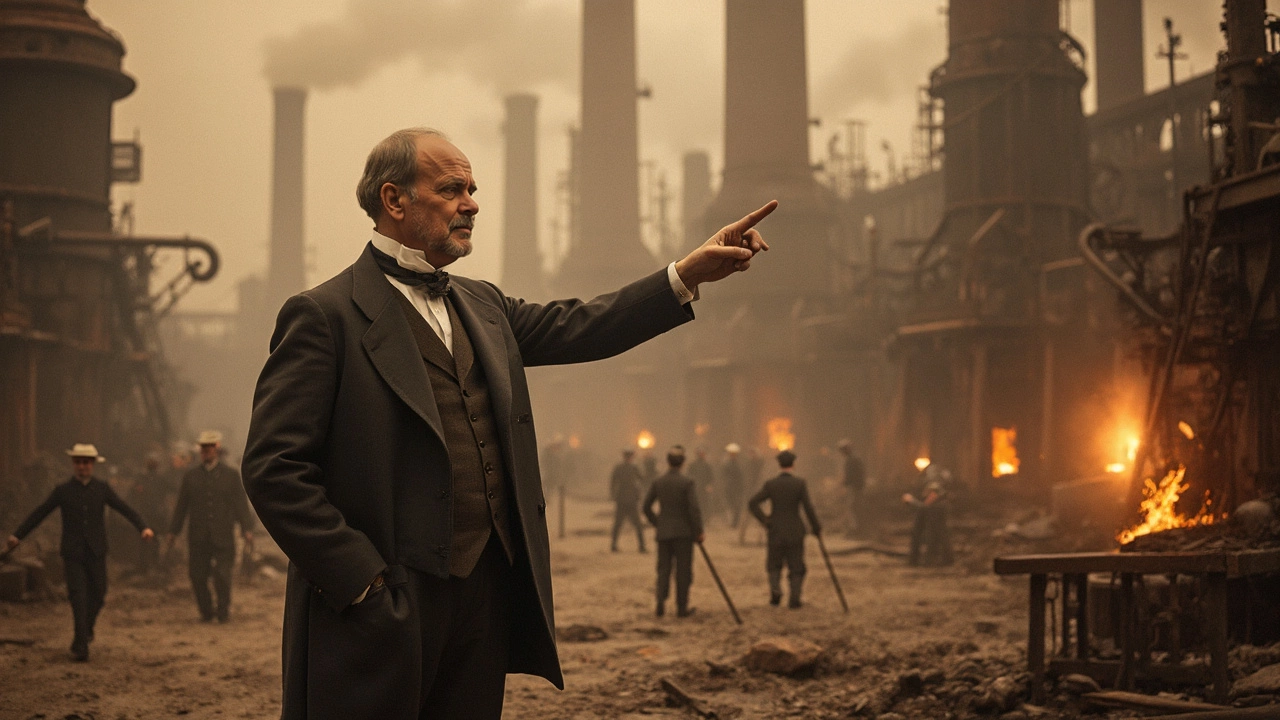When you think about the titans of the steel industry, one name stands tall above the rest: Andrew Carnegie. The guy practically wrote the book on making big bucks from steel. He wasn't just a businessman; he was a game-changer. From humble beginnings, Carnegie climbed to the top and became the richest man in the steel world.
So, how did he pull it off? It wasn't just luck. Carnegie had this knack for spotting opportunities and wasn't afraid to invest heavily in technology and people. He understood the demand for steel was about to skyrocket with the growth of railroads and cities. So, he positioned himself right at the heart of it all.
- A Brief History of Carnegie
- The Business Strategies That Made Him Rich
- The Steel Empire's Impact
- Lessons from Carnegie's Success
A Brief History of Carnegie
Andrew Carnegie wasn't born with a silver spoon. He came into the world in 1835, in a cozy Scottish town named Dunfermline. Talk about humble beginnings. When he was just a kid, his family decided to pack up and head to America. They settled in Allegheny, Pennsylvania.
From an early age, Carnegie was all about making it big. He started out as a bobbin boy in a cotton factory, earning just $1.20 a week. Not much, right? But the guy was a hustler, always learning and catching up with what's new in the business world.
By the late 1800s, Carnegie had his eyes set firmly on the steel industry. He noticed a growing need for steel, especially with railroads expanding left and right. In 1870, he established his first steel company. Boy, did he know how to pick his battles!
The Climb to the Top
Carnegie didn't stop there. He kept growing and acquiring other companies, forming the Carnegie Steel Company in 1892. Just imagine - by the turn of the century, it was the largest of its kind in the world!
“The man who dies rich, dies disgraced.” - Andrew Carnegie
This quote speaks volumes about his mindset. In 1901, he sold Carnegie Steel to J.P. Morgan for a cool $480 million. Not too shabby, huh?
He then channeled his energy into philanthropy, quite literally shaping the modern-day steel manufacturing landscape with his wealth.
Quick Facts
| Year | Event |
|---|---|
| 1835 | Born in Scotland |
| 1848 | Emigrated to the USA |
| 1870 | Entered the Steel Industry |
| 1901 | Sold Carnegie Steel Company |
The Business Strategies That Made Him Rich
Andrew Carnegie didn't just stumble into wealth; he played it smart. His success in the steel industry can mainly be attributed to a mix of clever tactics and a relentless push for efficiency.
The Importance of Vertical Integration
Carnegie knew that to control costs and boost profits, he had to own each step of the steel production process. This move, called vertical integration, meant buying up everything from iron ore mines to railroads and ships. By doing so, he slashed dependency on suppliers and kept expenses low—a brilliant move that many businesses still emulate today.
Cutting Costs with Technology
Carnegie was all about innovation. He embraced the Bessemer process, a new way of converting iron into steel, which was a lot faster and more efficient than the methods used before. This technological edge allowed him to produce steel way cheaper than his competitors, giving him a significant advantage.
Pioneering Labor Practices
Labor was another area where Carnegie excelled. He managed to get more output from his workers by introducing a system where their pay was based on productivity. It was tough, but workers had the chance to earn more if they hit their targets. This system not only maximized production but also kept the workforce motivated.
With a business empire as vast as his, it's no wonder Carnegie became a powerhouse in the steel manufacturing domain. He had the foresight to scoop up valuable assets and wasn't afraid to take risks. Today, his legacy inspires countless entrepreneurs aiming to make a mark.

The Steel Empire's Impact
Andrew Carnegie's steel empire didn't just change his life; it reshaped whole industries and communities. By the late 19th century, Carnegie Steel was the largest and most profitable industrial enterprise in the world. Imagine a time when demand for steel was booming—railroads were stretching across America, cities were sprouting skyscrapers, and everything from bridges to factory machines needed steel structures. Carnegie knew how to seize these opportunities, and his empire was right at the center of it all.
The Backbone of an Expanding Nation
Carnegie's impact was massive because his steel underpinned pivotal infrastructure projects. Railroads? They connected the East to the Wild West, thanks to Carnegie's rails. And let's not forget how steel bridges transformed travel and trade. The Brooklyn Bridge, completed in 1883, literally linked New York's boroughs with Carnegie’s steel as its backbone.
Economic Growth and Job Opportunities
The scale of Carnegie’s steel operations meant jobs—lots of them. These were crucial for immigrants flooding into America, looking for work and a better life. Working in steel plants wasn't easy, but it provided steady income. And it wasn't just about the laborers in the mills; Carnegie’s empire also spurred the growth of ancillary industries, like coal mining and iron ore extraction.
Philanthropic Legacy
Even after Carnegie's mighty rise in the steel industry, his influence stretched beyond just making money. He believed deeply in giving back and famously said that 'a man who dies rich dies disgraced.' True to his word, he gave away nearly 90% of his fortune. Libraries, universities, and cultural institutions all across the U.S. and the world still bear his name. These initiatives laid the groundwork for future generations to seek knowledge and innovation.
The legacy of Carnegie's steel manufacturing excellence isn’t just about the past; it's a blueprint for understanding industrial progress and societal development. The ripples of his empire’s impact can still be felt today.
Lessons from Carnegie's Success
Andrew Carnegie's journey from rags to riches in the steel industry is legendary, and there's plenty we can learn from his playbook. The key to his success wasn't just being at the right place at the right time; it was about making strategic moves and taking bold actions.
Embrace Innovation
Carnegie was never afraid to embrace new technology. He invested in the Bessemer process, which drastically reduced the cost of creating steel. This innovation allowed him to outpace competitors and offer products at a much lower price. So, the takeaway? Keep an eye on new tech and don’t hesitate to put your chips on revolutionary ideas.
Cost Control
One of Carnegie's famous strategies was controlling costs at every step. He did this by owning the supply chain, from raw materials to production. This vertical integration meant fewer middlemen and more profit. It’s a reminder that knowing where you can trim the fat is crucial in running a business smoothly.
Invest in People
Carnegie understood that his success was also built on the backs of his employees. He believed in rewarding talent and hard work, which helped him foster loyalty and attract the best minds in his field. A modern-day equivalent could be investing in professional development or creating a workplace where innovation thrives.
| Carnegie's Strategies | Impact |
|---|---|
| Innovation | Reduced costs, increased efficiency |
| Cost Control | Higher profit margins |
| Investing in People | Loyal and skilled workforce |
By dissecting these lessons, it's clear that success isn’t just about what you do but how you do it. Carnegie's example highlights that sometimes you need to be a bit daring, pay attention to details, and remember that investing in people often pays the biggest dividends. Not everyone can be the richest man in any industry, but these strategies definitely put you on the right path.











Write a comment